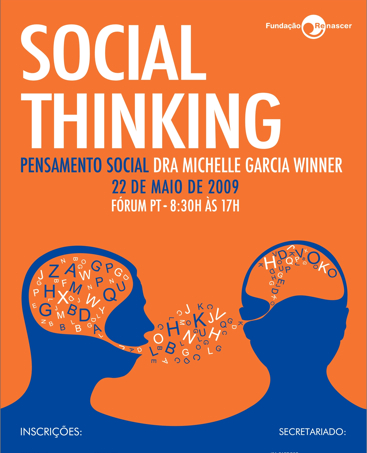By Michelle Garcia Winner, CCC-SLP
 Social thinking is what we do when we interact with people: we think about them. And how we think about people affects how we behave, which in turn affects how others respond to us, which in turn affects our own emotions.
Social thinking is what we do when we interact with people: we think about them. And how we think about people affects how we behave, which in turn affects how others respond to us, which in turn affects our own emotions.
Whether we are with friends, sending an email, in a classroom or at the grocery store, we take in the thoughts, emotions and intentions of the people we are interacting with.
Most of us have developed our communications sense from birth onwards, steadily observing and acquiring social information and learning how to respond to people. Because social thinking is an intuitive process, we usually take it for granted.
But for many individuals, this process is anything but natural. And this often has nothing to do with conventional measures of intelligence.
In fact, many people score high on IQ and standardized tests, yet do not intuitively learn the nuances of social communication and interaction.
(more…)
 Exploring Social Learning by Starting at our Roots
Exploring Social Learning by Starting at our Roots
By Michelle Garcia Winner, CCC-SLP
Learning evolves. The brain’s capacity to acquire new knowledge helps determine how and what we intuitively learn. Some learning happens as a matter of cognitive, social, and emotional development, i.e., from the “inside out,” while other learning happens “from the outside in.” For those of us who are neurotypical, social learning helps us bond with our caregivers early in life then paves the way for language development, more advanced relations, and an understanding of abstract social concepts that grows through experience and maturity.
Social learning is typically a process that evolves naturally, starting from birth and continuing across the life span. Children move from primarily adult-based interactions to observational discovery of their peers as the prelude to play. Play as a developmental milestone also encourages other relevant skills to emerge, such as cooperation, perspective taking, and emotional regard for others. Not coincidentally, as children develop the ability to cooperate and play in a group they are readying themselves to learn in a classroom, when at five years old they enter school. As children grow and move from second to third grade, internationally the curriculum shifts from rote learning in a group to critical thinking in a classroom. At this point children are expected to not only relate well person to person on the playground, but also determine the motives of a character in a storybook as well as make predictions about how characters are thinking and feeling. Alongside this academic and cognitive shift, a similar social/emotional change occurs. Children’s goal oriented play (tag, Four Square, etc.) evolves into deeper levels of personal connection, where children playfully relate to each other through conversational initiations and maintenance. Subtle but persistent advances in social development serve as the engine for subtle but persistent social emotional development. These advancing concepts are applied not only to our social interactions and group participation but also in the ways we interpret and respond to the curriculum within our coursework.
(more…)
 Social thinking is what we do when we interact with people: we think about them. And how we think about people affects how we behave, which in turn affects how others respond to us, which in turn affects our own emotions.
Social thinking is what we do when we interact with people: we think about them. And how we think about people affects how we behave, which in turn affects how others respond to us, which in turn affects our own emotions.